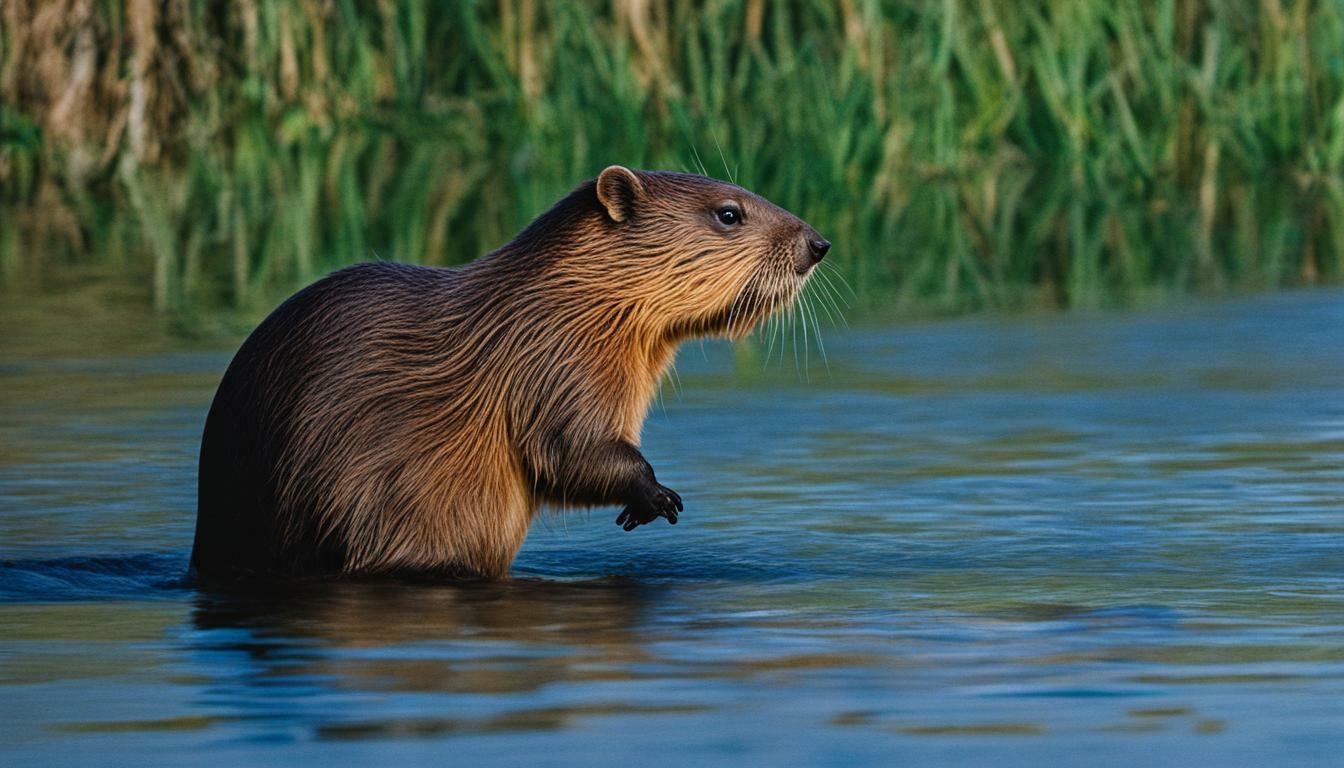Beavers are known for their characteristic tail slapping behavior, but have you ever wondered why they do it? This unique behavior serves as a communication tool within their colony, allowing them to warn others of potential danger or aggression. But there’s more to it than just communication. Let’s explore the fascinating reasons behind beavers’ tail slapping habits.
Key Takeaways:
- Beavers slap their tails as a warning shot before diving for cover.
- Both males and females engage in tail slapping, but studies show that males tend to do it more often.
- Tail slapping is also used to elicit responses, possibly when beavers encounter something they can’t figure out.
- This behavior helps startle potential predators and provides a safe escape into the water.
- Beavers’ tail slapping behavior plays a crucial role in their communication and survival as ecosystem engineers.
Understanding Beaver Tail Slapping
Tail slapping is an essential part of a beaver’s pond maintenance and communication strategies. These fascinating creatures use their powerful tails to create a loud noise by slapping the water’s surface. But why do they engage in this behavior, and what purpose does it serve?
Beavers are known for their ability to build intricate dams, which create ponds that serve as their homes and provide protection from predators. Tail slapping plays a crucial role in maintaining these habitats. When beavers sense danger or aggression, they rapidly slap their tails against the water, creating a warning signal for other beavers in the colony. This behavior alerts them to potential threats and prompts them to take appropriate action, such as seeking cover or diving into the safety of the water.
Studies have shown that both male and female beavers engage in tail slapping, but there are some differences in frequency. Male beavers tend to use this form of communication more often than females. It is believed that these gender disparities may be related to the roles each gender plays in building and maintaining the beaver dams. Tail slapping also serves as a means to elicit responses from their surroundings. When encountering something unfamiliar or puzzling, beavers may use this behavior to gain attention or communicate their confusion.
| Fact: | Male and female beavers both engage in tail slapping, but males tend to do it more frequently. |
|---|---|
| Beavers use tail slapping to communicate danger or aggression to other members of their colony. | |
| Tail slapping helps startle potential predators, allowing the beaver to escape to safety in the water. |
In addition to its role in communication and pond maintenance, tail slapping helps beavers startle potential predators. By creating a loud noise and disturbance in the water, beavers can surprise predators, giving them a chance to escape and seek refuge in their pond. This behavior is crucial for their survival and ensures the maintenance of their habitats.
In conclusion, tail slapping is a remarkable behavior exhibited by beavers that serves multiple purposes. It functions as a communication tool within the colony, alerts other beavers to potential dangers, and startles potential predators. This behavior highlights the adaptability and resourcefulness of these fascinating creatures and further emphasizes their role as ecosystem engineers.
Communication Through Tail Slapping
Tail slapping serves as a crucial method of communication among beavers, allowing them to convey important information to their colony members. This behavior is prevalent among both male and female beavers, although studies indicate that males tend to engage in tail slapping more frequently. By slapping their tails against the water’s surface, beavers create a loud sound that can be heard by others nearby, signaling danger or aggression.
Beavers also use tail slapping when they encounter something they can’t quite figure out, indicating their desire to elicit a response from their surroundings. This behavior serves as a way to catch the attention of other beavers and prompt them to investigate or provide assistance if needed.
Furthermore, tail slapping plays a crucial role in beaver’s defense against potential predators. When startled or pursued, beavers will aggressively slap their tails against the water, creating a loud noise that startles the predator. This behavior serves as a warning signal, allowing the beaver to make a quick escape by diving into the safety of the water. By maintaining their pond habitats through regular tail slapping, beavers ensure a secure and protective environment for themselves and their colony members.
| Key Points: |
|---|
| – Tail slapping serves as a communication tool among beavers |
| – Both male and female beavers engage in this behavior, but males do it more often |
| – Tail slapping is used to convey danger or aggression to other beavers |
| – Beavers also use tail slapping to elicit a response or assistance from their surroundings |
| – It serves as a defense mechanism against potential predators, allowing the beaver to escape to safety |
Warning Shot to Other Beavers
When a beaver slaps its tail against the water, it sends a warning signal to other beavers that danger or aggression is present. This behavior is used by beavers as a way to communicate and protect their colony. Whether it’s the presence of a predator or a territorial dispute, tail slapping serves as a call to action for other members of the beaver community.
Both male and female beavers engage in tail slapping, but research suggests that males tend to exhibit this behavior more frequently. It is believed that this gender difference may be linked to the male beaver’s role as the primary defender of their territory.
In addition to warning other beavers, tail slapping is also used by beavers when they encounter something unfamiliar or when they need to elicit a response. By using this behavior, beavers try to startle potential predators and gain a few crucial seconds to escape to the safety of the water. It is a remarkable adaptation that shows the ingenuity and resourcefulness of these ecosystem engineers.
| Key Points |
|---|
| Beavers slap their tails to communicate danger or aggression to other beavers. |
| Males tend to engage in tail slapping more frequently than females. |
| Tail slapping is also used to startle potential predators and allow beavers to escape. |
Gender Differences in Tail Slapping
Studies have shown that both male and female beavers engage in tail slapping, but males tend to exhibit this behavior more frequently. Beaver tail slapping is a form of communication used to convey danger or aggression to other members of their colony. It serves as a warning shot before the beaver dives for cover, providing a signal for others to be on alert.
Beavers, known for their meticulous dam-building skills, utilize tail slapping as a tool to startle potential predators. This behavior is often observed when beavers encounter something they cannot figure out or perceive as a threat. By slapping their tails against the water’s surface, they create a loud noise and splash, effectively startling potential predators and buying themselves time to escape into the safety of the water.
To further understand the significance of tail slapping in beaver communication, researchers have studied the gender differences in this behavior. While both males and females engage in tail slapping, studies have found that males tend to demonstrate this behavior more frequently. This disparity may be attributed to the roles each gender plays in beaver dam building. Males are typically responsible for constructing and maintaining the dams, making them more active in defending their territory and communicating potential threats through tail slapping.
Table 1: Gender Differences in Tail Slapping
| Gender | Frequency of Tail Slapping |
|---|---|
| Male | Higher |
| Female | Lesser |
Overall, beaver tail slapping is an essential behavior that plays a crucial role in beaver communication and survival. It allows these remarkable creatures to warn others of potential dangers, startle predators, and maintain the safety and integrity of their pond habitats. The gender differences in tail slapping highlight the unique roles males and females have in the complex dynamics of the beaver colony.
Tail Slapping to Elicit a Response
Beavers also slap their tails at things they can’t figure out, possibly to elicit a response or gather information. This behavior showcases their intelligence and resourcefulness in dealing with unfamiliar situations. When confronted with an unknown object or disturbance in their environment, beavers will often rely on their tail slapping to assess the situation and determine the appropriate course of action.
This unique behavior serves as a way for beavers to communicate their curiosity or apprehension, signaling to other beavers or potential threats in the area. By slapping their tails against the water’s surface, they create a loud noise and noticeable disturbance, capturing the attention of those around them. This action prompts a reaction and allows the beaver to gauge the response, ultimately helping them assess the level of danger or the intentions of their surroundings.
Beavers’ tail slapping can be seen as a form of investigation or experimentation, as they seek to gather information about their environment. It is a way for them to test the waters, quite literally, and determine the appropriate action to take in response to a potentially unfamiliar or unpredictable situation. This behavior displays their adaptive nature and highlights their ability to navigate their surroundings effectively.
Table: Examples of Beaver Tail Slapping
| Scenario | Response |
|---|---|
| A foreign object appears near their lodge | Beaver slaps tail to alert other beavers and assess potential threat |
| A predator approaches the beaver’s vicinity | Beaver slaps tail to startle the predator and create a diversion for escape |
| Other beavers encroach on its territory | Beaver slaps tail to assert dominance and mark territory boundaries |
Overall, beavers’ tail slapping behavior serves as an integral part of their communication repertoire, allowing them to elicit responses, gather information, and ensure the safety and well-being of their colony. It is a fascinating aspect of their behavior that showcases their adaptability and resourcefulness in navigating their aquatic habitats.
Startling Potential Predators
By slapping their tails against the water, beavers startle potential predators, giving themselves a chance to escape to the safety of the water. This behavior is a natural defense mechanism that allows beavers to protect themselves and their colony from harm.
When beavers feel threatened or detect danger, they forcefully strike the water’s surface with their flat, broad tails, creating a loud noise that can be heard from a distance. This sudden and unexpected sound startles predators, such as wolves or bears, causing them to retreat or hesitate, giving the beavers valuable time to seek refuge.
Studies have shown that tail slapping is particularly effective in deterring predators by creating a distraction and disrupting their pursuit. It serves as a warning signal that communicates aggression and danger, alerting other beavers in the vicinity to the potential threat.
| Predators | Response |
|---|---|
| Wolves | Retreat or hesitate |
| Bears | Retreat or hesitate |
| Other animals | Alerted to potential threat |
Beavers are well-known for their ability to build and maintain elaborate pond habitats. Tail slapping plays a crucial role in their pond maintenance efforts. By signaling potential threats and startling predators, beavers can ensure the safety and longevity of their ponds, which provide them with food, shelter, and protection.
The Importance of Beaver Tail Slapping
Tail slapping plays a crucial role in the overall behavior and communication strategies of beavers, ensuring their successful functioning as a colony. This unique behavior allows beavers to convey important messages to their fellow colony members, helping them navigate their environment and protect themselves from potential threats.
When a beaver slaps the water with its tail, it serves as a warning sign to alert others of danger or aggression. By creating a loud noise and a visible splash, the beaver communicates the presence of a potential threat, allowing the colony members to take immediate action. This warning shot is especially important when it comes to warding off predators that may pose a risk to the beaver’s safety.
Both male and female beavers engage in tail slapping, but studies have shown that males tend to perform this behavior more frequently. This gender difference in tail slapping may be attributed to the roles each gender plays in the beaver community. Males are typically responsible for building and maintaining the beaver dams, while females focus on raising the young. Tail slapping may play a role in asserting dominance or communicating specific messages related to these roles.
Tail Slapping to Elicit a Response
In addition to serving as a warning sign, beavers also use tail slapping to elicit a response from their surroundings. When they encounter something unfamiliar or are attempting to communicate a specific message, they may engage in tail slapping to grab attention and initiate a reaction. This behavior highlights the adaptive nature of beavers and their ability to use various communication strategies to navigate their environment successfully.
Furthermore, tail slapping helps beavers startle potential predators and provides them with an opportunity to escape to safety in the water. The loud noise and sudden movement created by the tail slapping behavior can startle and confuse predators, giving the beaver time to retreat and seek refuge in their pond habitat. By utilizing this defense mechanism, beavers can protect themselves and their colony members from harm.
| Key Points |
|---|
| Tail slapping is an essential behavior for beavers, enabling effective communication within their colony. |
| Beavers use tail slapping to communicate danger or aggression to other colony members. |
| Males engage in tail slapping more often, potentially due to their roles in building and maintaining dams. |
| Tail slapping is used to elicit responses, startle potential predators, and ensure the beaver’s survival. |
Environmental Factors and Tail Slapping Patterns
Environmental factors such as habitat and conditions can impact the frequency and patterns of tail slapping behavior among different beaver species. These industrious creatures adapt their communication strategies to suit their surroundings, ensuring their survival in various environments.
Studies have shown that the availability of suitable pond habitats plays a significant role in tail slapping behavior. Beavers use their tails to communicate danger or aggression to other members of their colony, and the frequency of tail slapping can increase in areas where potential predators are more abundant.
Additionally, the overall condition of the beaver’s habitat can influence the patterns of tail slapping. Beavers are known for their role as ecosystem engineers, constructing dams to create stable ponds. The maintenance of these ponds is crucial, as it provides them with protection and access to food. Therefore, beavers may increase their tail slapping behavior when they detect disturbances or threats to their pond habitats.
Table: Examples of Environmental Factors and Tail Slapping Patterns
| Environmental Factor | Tail Slapping Pattern |
|---|---|
| High predator presence | Increased frequency of tail slapping |
| Disturbances to pond habitat | Elevated tail slapping behavior |
| Abundant food resources | Reduced tail slapping frequency |
In conclusion, beavers’ tail slapping behavior is influenced by the environmental factors they encounter. From predator risk to pond habitat disturbances, these factors shape the frequency and patterns of tail slapping among different beaver species. By using this unique communication method, beavers demonstrate their adaptability and resourcefulness in maintaining their colonies and ensuring their survival.
Conclusion
Beavers’ tail slapping behavior serves as a crucial form of communication, playing a vital role in their survival as ecosystem engineers. This fascinating behavior is used by beavers to communicate danger or aggression to other members of their colony. By slapping their tails on the water’s surface, they effectively warn other beavers about potential threats, ensuring the safety of the entire group.
Both male and female beavers engage in tail slapping, but studies have shown that males tend to do it more often. This gender difference in behavior could be attributed to the males’ role in territorial defense and maintaining dominance within the colony.
Furthermore, beavers also use tail slapping as a way to elicit a response from their surroundings. When faced with unfamiliar situations or objects, they employ this behavior in an attempt to figure out what is happening or to prompt a reaction from nearby beavers.
Another significant aspect of tail slapping is its function in startling potential predators. By creating a loud noise and disturbance on the water’s surface, beavers are able to startle predators and gain precious time to escape into the safety of their aquatic habitat. This behavior not only ensures the individual beaver’s survival but also contributes to the overall maintenance of their pond habitats.
In conclusion, beavers’ tail slapping behavior is a remarkable adaptation that allows these industrious creatures to effectively communicate, defend their territories, elicit responses, and startle potential predators. It is an essential tool for their survival and successful functioning as ecosystem engineers, shaping and maintaining their habitats for years to come.
FAQ
Why do beavers slap the water with their tails?
Beavers slap the water with their tails as a warning shot before diving for cover. They use this behavior to communicate danger or aggression to other members of their colony.
Do both male and female beavers slap their tails?
Yes, both males and females slap their tails. However, studies show that males tend to do it more often.
Why do beavers slap their tails at things they can’t figure out?
Beavers may slap their tails at things they can’t figure out to elicit a response. This behavior is used to startle potential predators and allow the beaver to escape in the water.
What is the purpose of beavers slapping their tails?
Beavers slap their tails to communicate danger or aggression to other beavers, startle potential predators, and elicit a response when they can’t figure something out.




